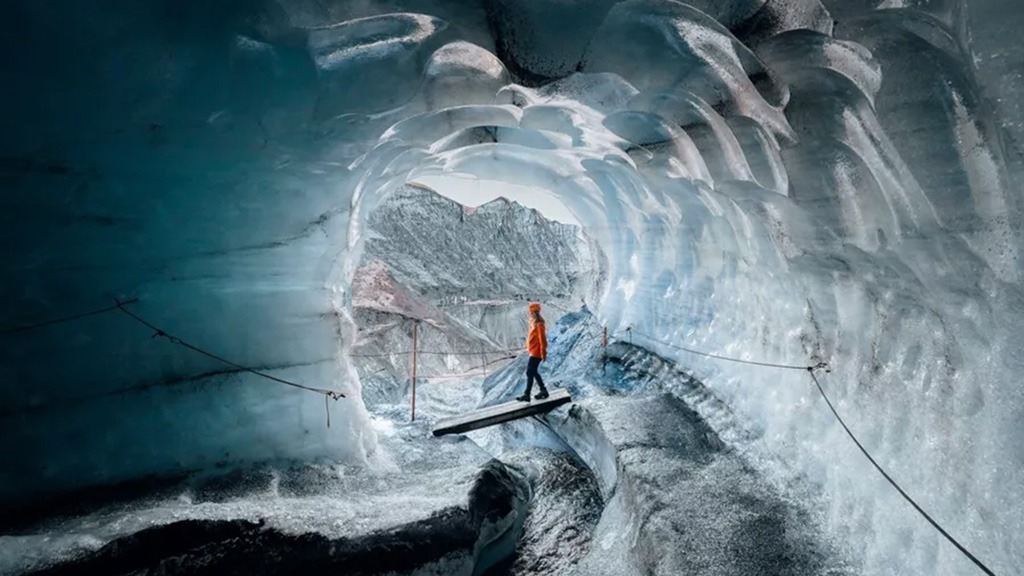When winter returns to Iceland, the landscape transforms into something almost otherworldly. Beneath the glaciers, a hidden world stirs to life — a labyrinth of ice caves that shimmer in shades of blue, silver and ash-black, forming anew each year as freezing water sculpts the glacier’s heart.
From October to April, guided tours take visitors deep beneath the frozen surface, where walls of compacted ice catch and bend the light like glass. Here, blue light glows through crystal corridors, sometimes veined with dark ribbons of volcanic ash — silent reminders of Iceland’s fiery past. These fleeting formations are nature’s seasonal art: by spring, meltwater and pressure erase them entirely, leaving a blank canvas for the next winter to begin again.
A new landscape every season
Each visit to an Icelandic ice cave is unique. The tunnels shift and reform with the freeze-thaw cycle, meaning no two seasons — or even weeks — are the same. For travellers, this makes every journey into the ice a one-of-a-kind experience, shaped by geology, weather, and chance.
During the 2025/26 season, ice caves in Vatnajökull National Park — Europe’s largest glacier — remain the country’s star attraction. The park works closely with the Nature Conservation Agency of Iceland to ensure that tours are conducted safely and sustainably, with expert guides leading small groups into these fragile environments.
One of the most famous, the Crystal Ice Cave, lies close to the Jökulsárlón Glacier Lagoon in southeast Iceland. Its striking blue ice and cathedral-like chamber draw visitors from around the world between October and April. The colours are caused by centuries-old ice that has compressed air bubbles out of existence, allowing only blue wavelengths of light to pass through.
Not far away, the Skaftafell Blue Ice Cave offers another remarkable natural tunnel, accessible via a guided hike across the glacier itself. The experience combines adventure and serenity — the crunch of crampons, the distant creak of moving ice, and the sudden, breathtaking quiet once inside.
Where fire meets ice
Further west along the South Coast lies one of Iceland’s most extraordinary natural contrasts: the Katla Ice Cave, which sits atop an active volcano. Unlike most ice caves that melt away each spring, Katla’s subterranean chamber remains open year-round. The ice here is streaked with black volcanic ash, giving it a marbled appearance that feels at once ancient and alive.
Tour operators describe Katla as “a meeting of fire and ice” — a geological reminder that Iceland’s beauty often comes from the balance of opposing forces.
Into the Glacier: Iceland’s man-made wonder
For those seeking a year-round glacier experience, the Langjökull Glacier Tunnel, known as Into the Glacier, offers a different perspective. This vast, man-made corridor burrows deep inside Iceland’s second-largest glacier in the Western Highlands. Stretching hundreds of metres beneath the surface, it allows guests to step into the heart of the ice cap — an immersive glimpse into the forces shaping Iceland’s highlands.
While natural caves like Vatnajökull’s form and fade with the seasons, Langjökull’s tunnel remains accessible throughout the year, offering a stable, family-friendly option for travellers visiting outside the main winter season.
A year-round adventure
Even as the famous ice caves close with the arrival of spring, Iceland’s glaciers remain open to exploration. Glacier hiking, snowmobiling and guided climbing tours operate year-round on Sólheimajökull, Langjökull, and Mýrdalsjökull, each offering new ways to experience the country’s frozen wilderness.
Travellers can join excursions led by Arctic Adventures, a local tour operator specialising in nature-based experiences. With expert guides trained in glacier safety and environmental stewardship, the company focuses on connecting visitors with Iceland’s wild landscapes while supporting sustainable tourism.
A fleeting world beneath the ice
What makes Iceland’s ice caves so mesmerising isn’t just their beauty — it’s their impermanence. Every winter brings a rebirth; every spring, a farewell. Visitors who venture inside glimpse a living landscape in constant motion, shaped by the same elemental forces that have defined Iceland for millennia.
Standing in the blue glow of a glacier’s heart, you can feel time itself — frozen, fleeting, and endlessly renewing.


